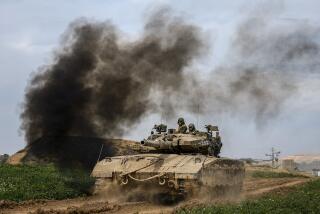Cease-fire accord said to be reached in Syrian city of Homs
Reporting from Beirut â A cease-fire accord has reportedly been struck that would bring the war-battered Old City of Homs back under government control by allowing the evacuation of hundreds of rebels, according to various reports Friday.
The deal, if it is implemented, would represent a victory for the government of President Bashar Assad ahead of national elections scheduled for June 3.
More than three years into the punishing Syrian conflict, authorities want to convey an image of relative normalcy for balloting that is expected to give Assad another seven-year term. The government has notched significant battlefield gains in recent months, especially in central Homs province and in and around Damascus, the capital.
But each day brings new reports of attacks, many with civilian casualties. And vast swaths of Syria, especially in the north and east, remain beyond government control. Government officials have been eager to evict rebels from the city of Homs, long dubbed the âcapitalâ of the uprising against Assad.
There was no official confirmation Friday that the government and opposition in Homs had reached an accord. But news websites on both sides of the conflict reported that an agreement had been struck allowing remnant rebel forces to leave Old Homs. Details of the accord varied.
Representatives of the two sides have been negotiating behind closed doors for weeks. The Army has laid siege to Homsâ ancient quarter for much of the last two years, cutting off supplies and food to rebel-held neighborhoods inside the once-vibrant Old City, now largely abandoned and in ruins after months of shelling and gun battles.
âYou could say the deal is done,â said one person familiar with the negotiations, who asked not to be named for security reasons. âIt should be implemented in the next 24 to 48 hours.â
The prospective deal would allow the remaining rebels to leave the Old City and head to opposition-held areas north of Homs. They would be permitted to carry personal arms, typically AK-47 rifles, but not heavy weapons, said the person familiar with the talks. But at least one pro-government website said that departing rebels would have to surrender all their weapons.
Hard-liners on both sides have fiercely opposed any kind of deal. Some opposition advocates preferred fighting to the end, a battle that would likely take weeks or months. And many government supporters oppose allowing those they call âterroristsâ to go free after months of sniper fire and other rebel attacks that have cost many lives.
But the government reportedly prefers to avoid subjecting its thinly stretched forces to a bloody and destructive round of urban combat in the streets and alleys of the Old City.
How many rebels remain in the historic center of Homs is unclear. Estimates range from several hundred to as many as 1,000. Hundreds of ex-fighters have already laid down their arms and left the Old City in recent months under an amnesty program, Syrian officials say.
Several hundred civilians are believed to remain in the encircled Old City. Food, medical supplies and other items have long been in short supply there, though black-market goods have been available. Tobacco is a rarity; cigarettes sell for the equivalent of about $40 each, according to people who have recently evacuated the area.
In recent weeks, Homs has seen a surge of violence as the Army has begun a slow advance on the Old City. Al Qaeda-linked rebels have taken credit for a series of car bombings that have killed dozens of civilians in government-controlled neighborhoods.
Recent attacks throughout Syria fit a pattern that has become familiar after more than three years of conflict.
Rebels fighting to oust Assad use car bombs and mortars to target areas deemed pro-Assad. Government forces, meanwhile, pummel rebel-held zones with aerial bombardments.
On Friday, state media reported that a pair of car bombs in Syriaâs central Hama province killed 18 people, including 11 children.
Most of the casualties in Fridayâs twin car bombings were in the town of Jidreen, west of Hama, the provincial capital, state media said. A suicide bomber there detonated a booby-trapped car, killing 17, including 11 children, and injuring 50 others, Syrian media reported.
The other car bomb attack took place in Hmairi, west of the provincial capital, killing one and injuring several others, the official Syrian news agency said.
State media showed photographs of bloodied, bandaged survivors, including children, receiving treatment in hospital beds.
No one took immediate responsibility for the attacks in Hama.
The government blamed âterroristsâ for the car bomb strikes, using its official term for anti-government rebels.
More to Read
Sign up for Essential California
The most important California stories and recommendations in your inbox every morning.
You may occasionally receive promotional content from the Los Angeles Times.










